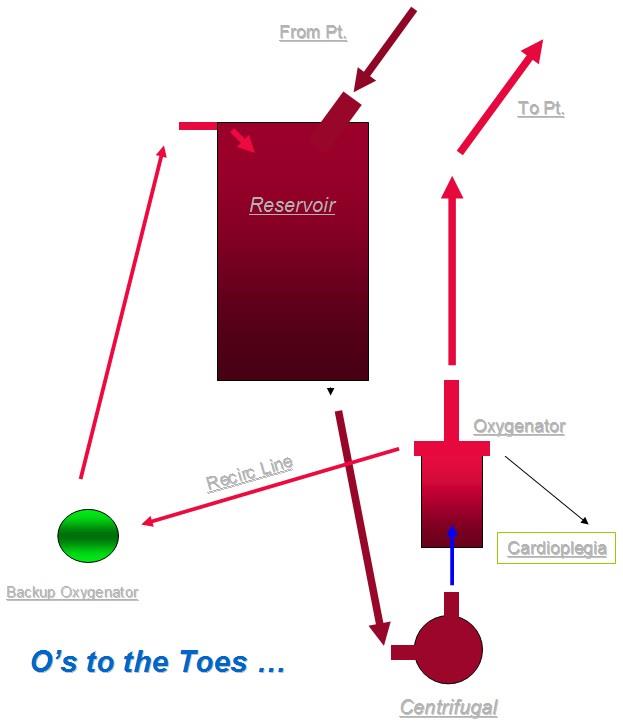Failing Oxygenator

Case Report-
Failing Oxygenator…
Operation:
Aortic Valve Replacement, End to End Graft from Aortic Root to Ascending Aorta.
Pt. Data
- 55 years old
- Gender excluded
- 71 inches
- 95 Kilograms
- 2.15 BSA
- Baseline Hematocrit- 48%
Pertinant Hx:
- Unremarkable.
- No coagulopathic issues
- No antiplatelet regimen
- Severe AI
- Mild AS
- Dilated Root
- No other issues- patient appeared to be very robust and healthy.
Plan:
AVR with possible root replacement, possible deep hypothermic circulatory arrest.
Prime Constituents: (After RAP)
- 300 ml Normosol
- 5,000 units heparin
- 25 g Albumin
- 100 g Mannitol
- 50 meq NaHCO3
- Prime volume estimated at < 1000 cc’s.
Approach:
- Oxygenator: Good Hx
- Membrane surface area- 2.5 m2
- Membrane surface area- 2.5 m2
- Circuit: Customized
- RAP and ultrafiltration concomitant to CPB
- 1% Forane on initiation of CPB
- 85% FiO2 3 liter sweep gas
- 4.5 to 5.5 Blood Q
- Cool to 32 C
- Retrograde Cardioplegia for onset and continuation of myocardial preservation.
- CSP Measured via CVP to be maintained at 50 mmHg with 1000 cc initial retrograde dose. KCL: 80 meq/L for initial arrest- reduced to 20 meq KCL/L for subsequent doses of 400 cc’s.
Timeline:
- On Pump
- Cooling
- + 2 minutes: Aortic crossclamp
- + 5 minutes: Cardioplegia delivered at 2 degrees C- x 4 minutes, Retrograde via coronary sinus- CSP pressure approximately 40-50 mmHg.
- Heart arrests at 600 or so cc’s of cardioplegia- the balance to 1000 cc’s is given.
- FiO2 is not adjusted for temp- remains at 85%.
- + 10 Minutes: the first blood gas drawn is unremarkable.
- Observation: CDI PO2’s seem to be in the 270’s or higher.
- Observation: Notice that CDI monitor shows PO2 dropping (<200) , SVO2 >70
- + 12 minutes: CDI monitor shows PO2 level dropping further- hovering around 150 or less.
- Status: 4.8 lpm / 33 degrees C / FiO2 @ 85% / SVO2 68%
- + 13 minutes or so… STAT ABG–
–
ABG Results:
- pH 7.47
- pCO2 60
- pO2 237
- SO2% 99.9
- Hct 33
- HCO3 44.4 (initial Bicarb in prime)
- BEb 18.6 (ditto)
- K 6.48 (Arresting dose)
- Gluc 148
- ACT 434
I immediately bumped up my O2 sat to 100%, and drew another sample- not because the blood gas results were alarming- but because the CDI values kept dropping. To be honest- I was concentrating so hard on the PO2- the PCO2 escaped me until the anesthesiologist on the case mentioned it. His point was well made… “well the pO2 isn’t scary (the gas showed 237- but he CDI was less than 150)– but the pCO2 is 60″.
When he said the pCO2 is 60– well that got my attention. At that point all the alarm bells were starting to go off. I increased my gas flow from 3 liters to 5.
The inability to blow off CO2 in tandem with a substantial decrease in the ability to oxygenate properly, O2 lines intact and demonstrated to NOT be a delivery issue- well the next stop is to look at the oxygenator.
Now the oxygenator has my total focus. Started running consecutive ABG’s one after the other. Just wanted to be sure. Continued my dialogue with the Anesthesiologist (a truly great resource- in this particular instance) and started to think of alternatives to the current oxygenation issue.
Drew another gas … (these results are 4 minutes after the previous ones)
ABG Results:
- pH 7.37
- pCO2 48
- pO2 139 (from 237 in 4 minutes)
- SO2% 99.5
- Hct 34
- HCO3 29.1
- BEb 3.9
- K 7.08
- Gluc 151
It’s seems that the increased respiratory bump worked (in terms of blowing off the CO2).
However- the PO2 dropped. So now it becomes apparent that there is an issue. The question is- which avenue and how to deal with it?
We are 20 minutes into a case that optimistically will be a 3 hour pump run, possibly longer. Pretty serious problem when you are at the bottom end of knowing what the true issue is.
A relatively new (to me) oxygenator in use here, that has demonstrated some serious attitude from quite a few prior runs. I have confidence in that.
However, things being what they are, being honest and believing your eyes and senses, are the quickest way to success. There is absolutely nothing in my clinical experience that can identify what is going on with the oxygenator / patient relationship- other than it is is beginning to fail in a really serious way- in a pretty serious hurry.
The fact that I don’t know why- really doesn’t matter. It’s not a Board question. What are you going to do about it- is in the best of terms- the the clinical question that begs the answer.
The baseline considerations have in my mind been reviewed, back to the bottom line- the simple question is… Can I get through this case continuing on the same course?
The answer is- clearly- NO…
–
Here is the run down on that:
- Notified the surgeon
- He asked “what are you going to do? “
- Switched to 100% O2
- 6.0 LPM gas Q
- bumped up blood Q to 5.6 LPM
- Pt Pressures maintained at 60 mmHg
- I have a plan- so I tell him- “I’ll fix it”.
- SVO2 has dropped to 65%- (and we’re at 33C)
It’s always a great plan if you can fix it…
Materials
- 1/4″ “Y” connector x 1
- LV vent tubing (has 3/8″ boot- with 1/4″ inch tubing on both ends)
- 20 Blade
- 2 clamps
- 1 Oxygenator
- 1 portable O2 tank
Approach
Since the oxygenator was functional in terms of blood flowing through it – (the ability to regulate patient temp and generate a cardiac output / pressure), my initial feeling was that if I didn’t have to change it out I wasn’t going to.
Much earlier in my career, a really good perfusionist (Chet) had convinced me that an in-tandem piggy back oxygenator was a solid option for dealing with oxygenator failures. I had tried it a couple of times since his sage advice, and it has always worked. The concept is simple. Cut in an oxygenator via your recirc line, and basically hyper-oxygenate your venous side of the equation. The rerouted blood is oxygenated and dumps back into your circuit via 1/4″ port to your venous reservoir. Since it returns into your reservoir, air is NOT an issue. So it becomes the simple task of splicing into the circuit 1 time, and making 2 connections.
Not exactly a veno-veno ECMO, but similar in concept.
And that’s exactly how it went. It takes about 2 minutes once you have all your ducks in a row. The total bonus is that there is no interrupted flow to the patient.
But it’s definitely a “gut-check” moment, as you wait to see if it works and that you made the right decision.
Well, It Worked.
ABG Results:
- pH 7.41
- pCO2 39
- pO2 273
- SO2% 99.9
- Hct 33
- HCO3 25.8
- BEb 1.8
- K 7.19
- Gluc 160
The rest of the case went smoothly, the pump run was a little less than 2 hours, and the adjunct oxygenator performed very well. ACT’s were maintained at >600 levels for the duration of the case.
Let me know what you think- if there was anything else that could or should have been done ?
Click image to enlarge







